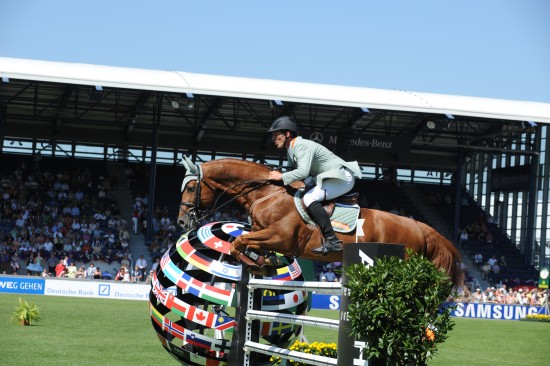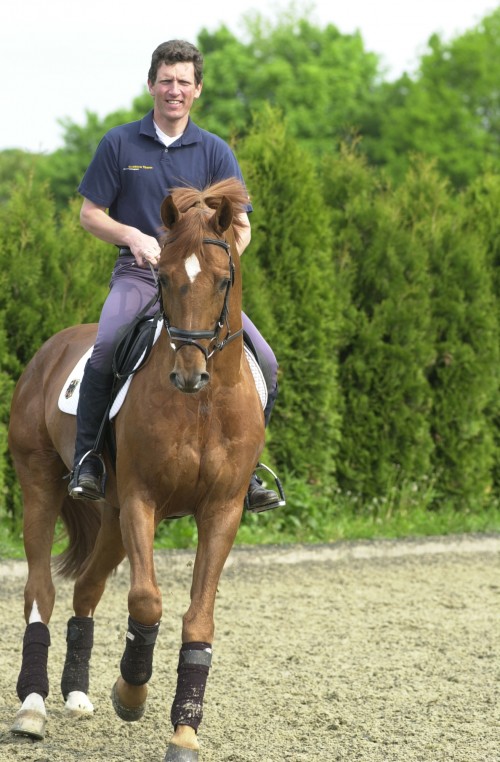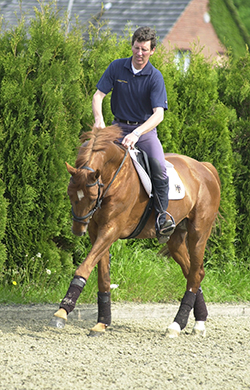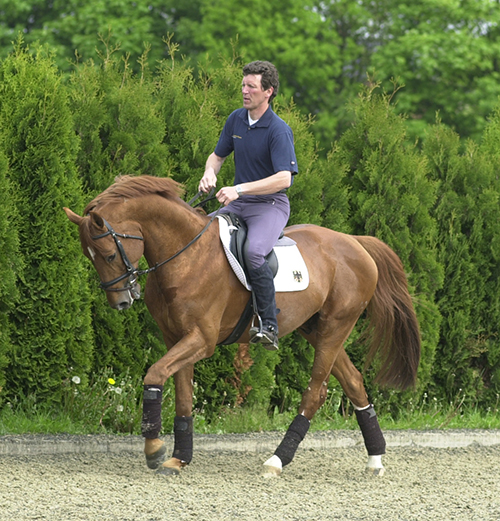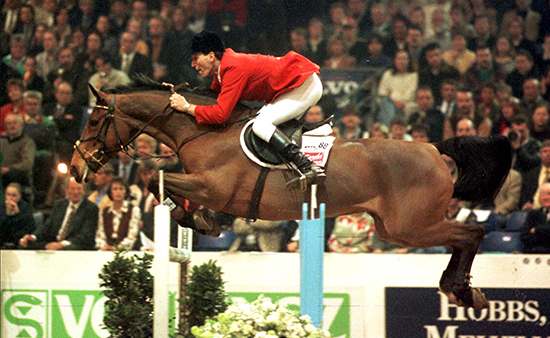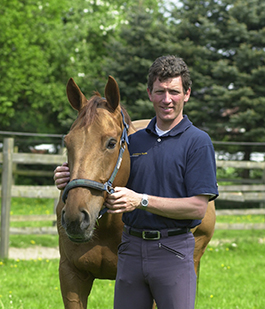The German showjumping rider, Ludger Beerbaum has been a dominating force in world showjumping for the past twenty years. It is somewhat of a surprise to find that he is such an unassuming and approachable interview: a rider who is also a thinker, and one who can express those ideas in such an interesting a lucid way.
In this wide-ranging interview with Chris Hector, Ludger examines most of the changes in the sport over the past two decades… Starting with the horse:
“For sure the type of horse has changed a bit. I remember starting to compete at shows in 1975, 76. Then starting to compete internationally in 85, and nearly twenty years later, we have horses with a lot more blood (ie. Thoroughbred), we have lighter horses – easier horses to ride. More rideability in the horses. It was quite a long process in the breeding but I am really happy that it developed that way. We have more and more people in Europe, especially in Germany, involved in showjumping, and more and more people starting to ride, especially in the past fifteen to twenty years, many many girls. We didn’t have many girls twenty years ago, they wouldn’t be able to ride those big strong heavy horses, this is another reason why we have more blood horses, lighter, easier horses.”
“We still have our Warmblood base. We don’t actually have Thoroughbreds, but horses with more and more Thoroughbred blood.”
Are you using more French blood?
“Not really more. Occasionally, like now I have a French horse, Champion de Lys. I saw him at a show and I really liked him. I bought him because I was enthusiastic about his jumping ability, not really because I thought I need a French bred stallion here on my German bred mares, that is just secondary. OK, I have been breeding with him for three years, and it looks as if he is successful. I have a couple of really nice foals. They are good types, they are big enough – because he himself is not the biggest horse – and he is a light horse but here with the German mares, especially where we live in Westfalia, the base is a little bit the old fashioned type – so I think this stallion is in the right place to breed.”
What about the arguments that the French horses are bad in the mouth, difficult to ride…
“I don’t think there are good mouths and bad mouths, that is something I don’t understand. I think it is the conformation. If the conformation is good and the horse is sound, 95-98% are good in the mouth, unless they have a problem with their teeth or something. If the conformation is not good – if they are out behind, or downhill, tight shoulders, or they don’t have enough neck – or if they have a soundness problem, then for sure they have a problem in the mouth. They get stiff in the back, they get strong in mouth. I think this is a little bit the problem the French had. They were not looking very much at the conformation in breeding, they took everything, where the blood was good they said ‘ok let it breed’.”
“In Germany, especially in Hanover they were really looking for the material, selecting at two and a half, and if they were not good enough, not sound enough, they didn’t breed with them. I think the Hanoverians are producing the best horses, really. In the north, in Holstein, they were not too careful with the conformation and with the soundness, there is a lot of French influence there, but there horses are the most difficult to ride, nervewise, mouthwise, they have very straight hindlegs, they have problems with the hooves.”
One of those Hanoverian stars – Ludger at home with the stallion, Goldfever…
Has the training of jumping horses changed with the type of horse?
“With this development in the sport, we had a change in the course building as well, everything got more technical and a little bit lighter. We don’t have the heavy strong fences we had fifteen / twenty years ago. If you look at a video from Aachen twenty years ago, and from Aachen now, the changes are unbelievable. We don’t have these big bushes and oxers – now there’s light poles, and the horses can knock them down easy, and they go really fast. Before they used to ride with much more control, they landed and instead of 3 / 4 / 5 strides between the jumps – there was a jump and then sixty metres and the next jump, fifty to the next one… This has also changed the work with the horses. The riding is much more forward, the speed is much more a factor than it used to be. It used to be clear round jumping. Still now to win a class you have to be clear, but you also have to be able to go fast and take sharp turns. It is also for the followers – the media, the television, the crowd – they don’t want to see fifteen slow clear rounds, they want an exciting sport. In the daily work, you have to have a rideable horse. These lighter horses, they are easier to ride. You don’t need strong bits any more, you don’t need short martingales – you know, the German way of working a horse, with a short martingale and the head down. (Ludger laughs, it is clear that he has moved a long way from that old stereotype) You are never fast enough with the head down. German horses now go with the head up and forward. OK for the back and for the muscles you still need the draw reins, but you don’t rely on the draw reins. You can work your horse in balance with the head up. You have to have an educated horse, a horse that is listening to you on the flat – but not more – you don’t need over-controlled horses.”
How much work do you want to do on the flat – do you want horses to do half pass….
“Basically I believe the more dressage education you have, the more you are in harmony with your horse, then you have 100% control. You have to look at it realistically. If I look through my horses, then I give a different answer for every horse. There’s the horse that for some reason is a little bit lazy or stiff, not the most enthusiastic worker every day – then this one I have to push a little to make listen, to bend, to move sideways. Then, I have the French horse, Champion du Lys, he is a super light horse. Every day enthusiastic to go, and so with him I don’t do sideways or anything, I just go nicely with him in the country, or on the track, because he is naturally so rideable and so good in the mouth, so sensitive to my legs. He is always listening. This is not a horse that needs a lot of dressage work, while a horse like Figaro’s Boy, he’s a bit lazy, and he gets a little cold, he’s not the strongest horse with his hind legs, and with him I have to be really careful to not over-work him. If I would make him bend a lot, and go sideways, and really use his hind legs, then I could put too much stress on his not-too-strong ligaments and muscles in the hind legs and the hocks. Then you have a problem with a lame horse. With him I try to have as much control as possible, but you must not create a problem by asking too much. We need control for showjumping, we must be able to go forwards and backwards, but we don’t really need the 100% perfect educated dressage horses. With certain horses in certain situations we must make compromises.”
Ludger with Ratina
When you get a horse that is going to be a superstar, how soon do you know?
“If depends on the situation and the circumstances. With Ratina, I knew when I got her she was a superstar, because that is what she had been with Piet Raymakers. She was very successful, winning everywhere, and Mr Melchior decided to sell this horse. He rang my owner and said I have to make money, are you interested in Ratina? My owner couldn’t really believe it that he was going to sell this horse… I had to give away my first horse, Classic Touch to the son of my owner, but I knew from the beginning that Ratina was a superstar. The problem was for me to adapt to the horse – whereas when you get a young horse that you think is really a cracker, you try to get the horse adapted your way. Ratina was ten when I got her, and it was the other way round. I knew she was hot, I knew she was a freak. I had to adapt myself to her.”
“Sometimes with a young horses, then you have time enough to try to get the horse in your system and your way. Sometimes I have a young horse and I think it is a superstar. I ride it a couple of weeks then you go to a show and think ‘oh shit’ because from his brain he is not there. He has the ability to jump super but when he gets into the ring he is watching the flags. He can’t cope with the music, or the atmosphere, or whatever. There are so many things you can’t tell from the beginning…. That can change everything. You get other horses and they go into the ring somewhere like Aachen and they jump higher and bigger, they are so pleased with the situation.”
Has it got to the stage where showjumping courses are so demanding that you need a ‘freak’?
“If you have one it’s brilliant, but with a well-educated horse you always have a chance. We have competitions throughout the whole year, indoors and outdoors, and the rider who has two or three well-educated horses can go as well as the rider with the freak. It is nice to have a freak, but there are not so many of them around.”
Where can course building go, it can’t get lighter or more technical or bigger….
“This is a very good question, and one we discuss between ourselves two or three times a year in the Jumping Riders club, with our federation, with our coaches. This is a really big question, and there is not so much to change technically. I think for sure speed, and turns, will be a factor. The ability to go fast and still keep the horse jumping in a good shape, I think this is going to be the way of the future.”
You were saying that the new horses were suitable for women riders, yet we haven’t had a German lady rider in the team since Frau Köhler – your brother’s wife doesn’t count, she is American…
“If you just look at the very top you are right, but just below the top, 85% are women.”
Why do you think the Americans have had all women jumping teams yet there haven’t been any women in the German teams?
“The Americans had Thoroughbred horses 25 years ago. In Dressage for the past 10-12 years, we have just had women, even in eventing, we have women riders in our teams. The showjumping is just ten years back but I think it is just a question of half a generation, and in Germany for sure we will have at least half women in our team. The showjumping career of a human being is quite a long time. I’m 37 and I am already 15 years in the sport – normally, if everything goes right I should have another ten years. The same with Franke Sloothaak, or Otto Becker. It is not so easy for the women to push us aside but it will be soon that we will have some German girls in the team. Two years ago we had three girls in the young riders team – at this level they are strong already. We have them.”
Is it harder competing on a breeding stallion like Goldfever? Is it hard for them mentally when you are collecting semen, for them to go out and compete?
“For sure it affects the stallion, there is no doubt about that, especially now in the spring time you realise it. There are days when you need fifteen minutes to get their concentration. Some days when you go to a competition and you are just about to go into the ring, and a mare goes by and she might be in season – when you get into the ring you realise the horse is not really listening to you, he is somewhere else, maybe not completely, but that is one of the problems with a stallion. It is much easier to get consistent performance from a mare or a gelding.”
Can your European Champion Gladdys become one of the great ones?
“If her way continues like it has, she can be as good as the best I’ve had – as good as Ratina or Classic Touch. She is by Grandeur, the stallion that was ridden by Thomas Frühmann, and the mare by Apart by the Thoroughbred, Angelo. She is Westfalien bred with a lot of Hanovarian blood.”
“She has all the scope, she is super careful and she is very very fast. When I got her, she was not the strongest horse. She was a little weak behind, she had arthroscopy on one knee. At first I wondered if she was strong enough, but at the moment it looks okay and her ability is great.”
With the mare – Gladdys
Three top horses and they are all mares….
“Looking back when I was a junior, the first really important horse to my career was a mare, a chestnut mare like Gladys. From then on the main horses were mares, not because I believed that mares are the strongest, but looking back, I must say I prefer mares because I believe that if it gets really to the point where they have to be extraordinarily strong and mentally tough, the mares are stronger than the stallions and the geldings, that’s for sure.”
You’ve been competing for 25 years now, is it still exciting, or is it just another job?
“No, it’s very very exciting. For sure, it is my job but I really enjoy doing it. Every year is different, you get new horses, or things are going well, then the next time when you think they should go well, they don’t. Even when you go to the same show year in, year out, it is not the same, it is always exciting because you never know 100% what will happen, did you do the right preparation? Is the horse fit at the right time? It’s still very exciting.”
Originally appeared in The Horse Magazine in 2006



